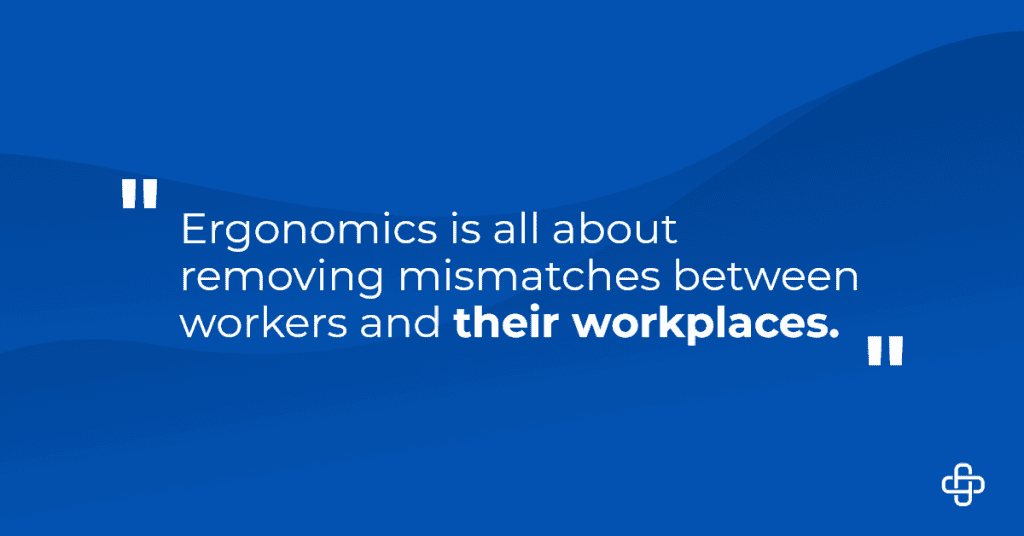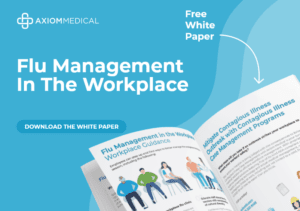When we hear the word “ergonomic,” our minds usually go straight to back support and seating. But the world of ergonomics actually covers much more than desk and chair design.
A workspace’s lighting? That’s ergonomic design. Noise levels? That’s ergonomic design too. Equipment layout and how it influences a worker’s cognitive load? You guessed it. Ergonomics is all about removing mismatches between workers and their workplaces. By drilling down into different design elements, employers can help employees feel greater synergy with their work environments. These changes usually involve added costs, but data shows that these ergonomic expenditures pay themselves off in the end.

Here’s a look at the top ergonomic trends leading the way in 2025 and how they’re transforming workplaces for the better:
Table of Contents
| 1. Wearables: The Latest Fashion Statement in Safety |
| 2. Designed for the Grind: Ergonomic Workstations |
| 3. Power Up with Health Gamification |
| 4. Put Down Roots at Work with Biophilic Design |
| 5. Think Smarter, Not Harder: The Cognitive Ergonomics Advantage |
| New Year, New Ergonomic Opportunities |
1. Wearables: The Latest Fashion Statement in Safety
Wearables have been gaining traction in ergonomics, and this trend will continue in 2025. These compact devices provide real-time safety tools designed to monitor and enhance workers’ well-being. Detecting dangers before they strike can go a long way in keeping workers safe and preventing recordables.
The utility of wearables shines through in all sorts of industry-specific scenarios. Just a few dangers wearables can proactively detect are:
- Poor posture: Sensors in wearables can identify when a worker’s posture could cause strain or injury, providing immediate alerts to encourage better positioning and reduce long-term harm.
- Toxic fumes: Wearables equipped with air quality sensors can detect harmful gases or chemical exposure, ensuring workers can take immediate actions to avoid health risks.
- Unsafe temperatures: Whether it’s extreme heat in industrial settings or freezing conditions outdoors, wearables can monitor temperature levels and alert workers before these conditions lead to heatstroke or hypothermia.
- Exhaustion: By tracking physical activity and patterns, wearables can identify signs of fatigue or overexertion, prompting appropriate breaks to prevent injuries linked to tiredness, like slips or missteps.
- High-risk locations: With GPS functionality and proximity sensors, wearables can warn workers when they get too close to unsafe zones, such as heavy equipment, live wires, or unstable areas.
Being aware of these risks before they become obvious helps employers and employees make precise adjustments to prevent potential accidents. Companies at the forefront of this trend are enjoying these payoffs firsthand; they see fewer injuries and absences while feeling safer.
2. Designed for the Grind: Ergonomic Workstations
Small changes to the job site can make a big difference to workers who stand, lift, or do reoccurring movements throughout their shifts. These tailored setups improve worker comfort by addressing physical stressors like poor posture, extended standing, and repetitive motions. By reducing the risk of injuries such as back pain, joint strain, or repetitive stress conditions, ergonomic workstations create a safer environment that keeps employees healthier.
What changes make the biggest difference in the workplace?
- Height-adjustable platforms: Workers can adjust these platforms to fit their needs and feel more comfortable.
- Anti-fatigue flooring: It adds cushion underfoot, making it easier to stand for long hours. For example, someone in a warehouse can stay on their feet longer without as much pain.
- Temperature-regulated control rooms: A workspace that stays cool in the summer or warm in the winter keeps workers focused and feeling good all day.
- Ergonomic seating: Adjustable chairs with proper lumbar support allow workers who sit for extended periods—such as office employees or machine operators—to maintain better posture. This reduces the risk of chronic back pain and boosts overall comfort.
- Workstation lighting improvements: Adding adjustable task lighting reduces eye strain, especially for jobs requiring attention to detail, like manufacturing or assembly. Brighter, focused lighting ensures workers can perform tasks with precision and reduces mistakes caused by poor visibility.
- Tool balancers and assistive devices: Equipment that helps workers handle heavy tools or materials, like spring-loaded tool balancers or hydraulic lifts, minimizes strain and repetitive stress injuries while improving efficiency for physically demanding tasks.
In the name of efficiency and productivity, it’s always a better choice to adjust the workplace to the worker. More ergonomic setups in the workplace will allow workers to focus on their tasks without the distraction of discomfort.
3. Power Up with Health Gamification
Workplace health, which can have life-or-death consequences, is not a game. Yet, applying game-like elements to health initiatives can support long-term wellness for workers. The endorphin boost that comes with scoring points can heighten participation in health management and motivate teams to make it into a habit.
The easiest way to introduce gamification is through workplace health apps. These tools allow employees to monitor progress and set goals, making health management actionable and dynamic. Commonly tracked goals include:
- Daily step counts: Encourages physical activity during shifts, promoting better cardiovascular health.
- Staying hydrated: Tracks water intake throughout the day, reducing fatigue and boosting concentration.
- Stretching or mobility exercises: Supports muscles and joints, preventing strain caused by repetitive tasks.
- Stress management activities: Includes mindfulness exercises or relaxation breaks to improve mental well-being.
- Healthy dietary choices: Logs nutritious eating habits or encourages opting for healthier snacks or meals.
Of course, the magic of gamification is in the rewards. For instance, an app might grant points for taking stretching breaks or achieving hydration milestones, which workers can redeem for small rewards like gift cards, extra break time, or even workplace perks like priority parking or recognition in team meetings. Making healthy choices an engaging challenge ignites excitement and keeps participation steady across the workforce.
Looking ahead to 2025, ergonomic health gamification is poised to continue to sweep workplace culture. These efforts not only prevent injuries and burnout but also give workers a reason to feel more connected and valued every day.
4. Put Down Roots at Work with Biophilic Design
Biophilic ergonomics is shaping up to be a major trend in workplace design by 2025. A biophilic workspace is one that adds touches of nature to the workspace. The concept may sound lofty, but its execution is straightforward—creating workspaces that feel more connected to nature. The payoff is that physical and visual access to natural elements improve worker satisfaction.
What does biophilic design look like in action? Here are some common elements making their way into workplaces:
- Indoor plants: From a simple desk plant to expansive green walls, greenery softens harsh environments and helps purify the air.
- Large windows for natural light: Sunlight not only brightens a room but also boosts mood and energy levels, reducing reliance on fluorescent lighting.
- Water features: Small fountains or aquariums add a calming effect, promoting relaxation and focus.
- Natural materials: Incorporating wood, stone, or bamboo into furniture or décor creates a warm and welcoming environment
Looking toward the future, biophilic design is set to become a standard for workplaces across industries. Take break rooms, for instance. Adding natural elements like comfy seating, live plants, and access to fresh air turns a routine break into a moment of genuine relaxation. Even in heavy industries where nature seems far removed, biophilic principles are being integrated. Break areas with improved lighting, better ventilation, and inviting layouts help reduce both mental and physical stress. Thoughtful designs like clearing walking paths or reducing crowding also make work environments safer and more efficient.
5. Think Smarter, Not Harder: The Cognitive Ergonomics Advantage
Cognitive ergonomics has been trending in industrial workplaces, and 2025 should be no different. Mental health and cognitive load deserve just as much attention as physical well-being, particularly in physically demanding environments. By designing tools and workflows that reduce mental fatigue, workplaces can help employees stay focused, make fewer mistakes, and feel more in control of their tasks.
Here are some cognitive ergonomic strategies making an impact in industrial settings today:
- Clear signage: Easy-to-read signs ensure workers can quickly grasp important information, especially in fast-paced environments, reducing decision-making time and errors.
- Intuitive controls: User-friendly control panels simplify complex tasks and make operating heavy equipment safer and more efficient.
- Task simplification: Breaking down larger tasks into smaller, manageable steps prevents cognitive overload during long shifts.
- Stress management tools: Apps for mindfulness or guided meditation help workers manage stress and stay calm, even during high-pressure situations.
- Automation of repetitive tasks: Removing tedious, manual tasks through automation allows employees to focus on problem-solving and creative thinking, ultimately increasing job satisfaction.
Addressing cognitive ergonomics isn’t just about improving efficiency—it’s about supporting the mental well-being of workers in demanding roles. Automated systems and thoughtfully designed workflows ease the cognitive burden, while tools like meditation apps provide workers with a way to recharge mentally during their day. These changes not only reduce fatigue but also create an environment where employees feel valued and empowered.
Employers play a critical role in fostering this supportive environment. Take a moment to evaluate your workspace. Are tools and systems designed to help workers focus and succeed? Better yet, ask your employees directly how their workspaces affect them. By gathering input and making thoughtful adjustments, you can create a workplace where focus, efficiency, and well-being come together seamlessly.
New Year, New Ergonomic Possibilities
Time to put this article down and take in your environment. Can you think of any tweaks to your space that would make work easier and more enjoyable? If you’re an employer, be sure to ask your employees how their workspaces are working for them.
If you’d like to dive deeper into ergonomics in 2025, watch our recent webinar Next-Level Ergonomics: Advanced Programs to Transform Workplace Health with Ergonomist Dr. P Shakeel Marley, PT, DPT and Chief Medical Officer Dr. Scott Cherry.

Cain Boney is a contributor to Axiom Medical’s blog. With a career dedicated to writing about the workplace, Cain focuses on how employee well-being affects organizational success and sustainability in the long term.










